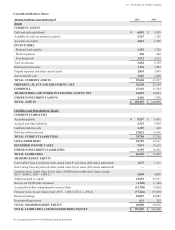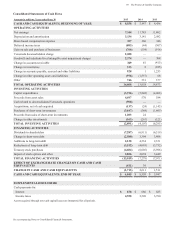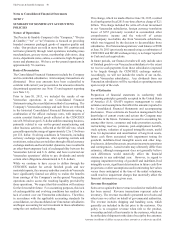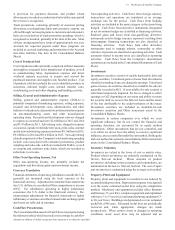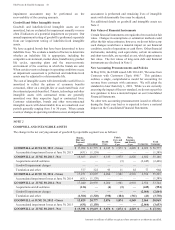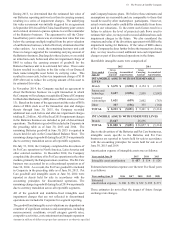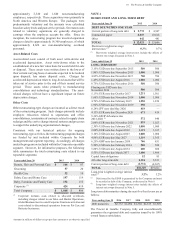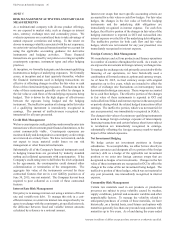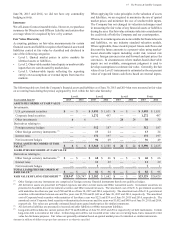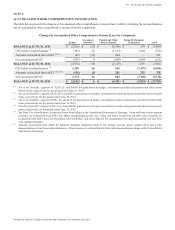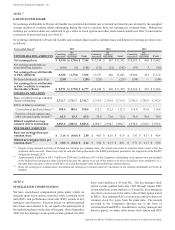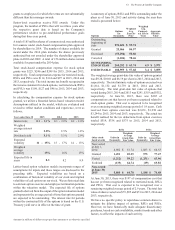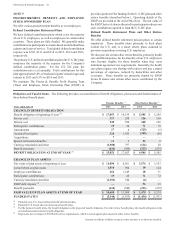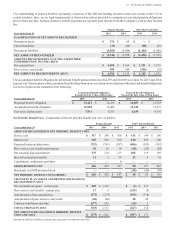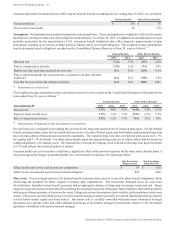Proctor and Gamble 2015 Annual Report Download - page 58
Download and view the complete annual report
Please find page 58 of the 2015 Proctor and Gamble annual report below. You can navigate through the pages in the report by either clicking on the pages listed below, or by using the keyword search tool below to find specific information within the annual report.The Procter & Gamble Company 56
Amounts in millions of dollars except per share amounts or as otherwise specified.
RISK MANAGEMENT ACTIVITIES AND FAIR VALUE
MEASUREMENTS
As a multinational company with diverse product offerings,
we are exposed to market risks, such as changes in interest
rates, currency exchange rates and commodity prices. e
evaluate exposures on a centralized basis to take advantage of
natural exposure correlation and netting. To the extent we
choose to manage volatility associated with the net exposures,
we enter into various financial transactions that we account for
using the applicable accounting guidance for derivative
instruments and hedging activities. These financial
transactions are governed by our policies covering acceptable
counterparty exposure, instrument types and other hedging
practices.
At inception, we formally designate and document qualifying
instruments as hedges of underlying exposures. e formally
assess, at inception and at least quarterly thereafter, whether
the financial instruments used in hedging transactions are
effective at offsetting changes in either the fair value or cash
flows of the related underlying exposures. Fluctuations in the
value of these instruments generally are offset by changes in
the fair value or cash flows of the underlying exposures being
hedged. This is driven by the high degree of effectiveness
between the exposure being hedged and the hedging
instrument. The ineffective portion of a change in the fair value
of a qualifying instrument is immediately recognized in
earnings. The amount of ineffectiveness recognized was
immaterial for all years presented.
Credit Risk Management
e have counterparty credit guidelines and normally enter into
transactions with investment grade financial institutions, to the
extent commercially viable. Counterparty exposures are
monitored daily and downgrades in counterparty credit ratings
are reviewed on a timely basis. e have not incurred, and do
not expect to incur, material credit losses on our risk
management or other financial instruments.
Substantially all of the Company's financial instruments used
in hedging transactions are governed by industry standard
netting and collateral agreements with counterparties. If the
Company's credit rating were to fall below the levels stipulated
in the agreements, the counterparties could demand either
collateralization or termination of the arrangements. The
aggregate fair value of the instruments covered by these
contractual features that are in a net liability position as of
June 30, 2015, was not material. The Company has not been
required to post collateral as a result of these contractual
features.
Interest Rate Risk Management
Our policy is to manage interest cost using a mixture of fixed-
rate and variable-rate debt. To manage this risk in a cost-
efficient manner, we enter into interest rate swaps whereby we
agree to exchange with the counterparty, at specified intervals,
the difference between fixed and variable interest amounts
calculated by reference to a notional amount.
Interest rate swaps that meet specific accounting criteria are
accounted for as fair value or cash flow hedges. For fair value
hedges, the changes in the fair value of both the hedging
instruments and the underlying debt obligations are
immediately recognized in interest expense. For cash flow
hedges, the effective portion of the changes in fair value of the
hedging instrument is reported in OCI and reclassified into
interest expense over the life of the underlying debt obligation.
The ineffective portion for both cash flow and fair value
hedges, which was not material for any year presented, was
immediately recognized in interest expense.
Foreign Currenc Risk Management
e manufacture and sell our products and finance operations
in a number of countries throughout the world. As a result, we
are exposed to movements in foreign currency exchange rates.
To manage the exchange rate risk primarily associated with the
financing of our operations, we have historically used a
combination of forward contracts, options and currency swaps.
As of June 30, 2015, we had currency swaps with original
maturities up to five years, which are intended to offset the
effect of exchange rate fluctuations on intercompany loans
denominated in foreign currencies. These swaps are accounted
for as cash flow hedges. The effective portion of the changes
in fair value of these instruments is reported in OCI and
reclassified into SG&Aand interest expense in the same period
or periods during which the related hedged transactions affect
earnings. The ineffective portion, which was not material for
any year presented, was immediately recognized in SG&A.
The change in fair values of certain non-qualifying instruments
used to manage foreign exchange exposure of intercompany
financing transactions and certain balance sheet items subject
to revaluation are immediately recognized in earnings,
substantially offsetting the foreign currency mark-to-market
impact of the related exposures.
Net Inestment Hedging
e hedge certain net investment positions in foreign
subsidiaries. To accomplish this, we either borrow directly in
foreign currencies and designate all or a portion of the foreign
currency debt as a hedge of the applicable net investment
position or we enter into foreign currency swaps that are
designated as hedges of net investments. Changes in the fair
value of these instruments are recognized in OCI to offset the
change in the value of the net investment being hedged. The
ineffective portion of these hedges, which was not material in
any year presented, was immediately recognized in interest
expense.
Commodit Risk Management
Certain raw materials used in our products or production
processes are subject to price volatility caused by weather,
supply conditions, political and economic variables and other
unpredictable factors. To manage the volatility related to
anticipated purchases of certain of these materials, we have
historically, on a limited basis, used futures and options with
maturities generally less than one year and swap contracts with
maturities up to five years. As of and during the years ended



